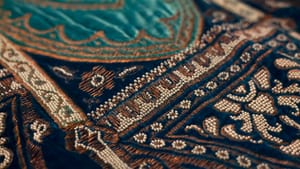Stay in the Loop
BSR publishes on a weekly schedule, with an email newsletter every Wednesday and Thursday morning. There’s no paywall, and subscribing is always free.
Drexel’s Immortal Beauty unveils extraordinary costumes to the public

Drexel University’s Robert and Penny Fox Historic Costume Collection, little-known to the public, might be one of Philly’s prime cultural secrets. Primarily used for teaching purposes, the Fox Collection boasts about 14,000 objects, from a fragment of 16th century Italian velvet to a 2012 Alexander Wang dress. For the first time ever, a portion of this trove will be on display in the exhibition Immortal Beauty.
Immortal Beauty tells the story of the Fox Collection and underscores the original mission of Drexel University. The exhibition takes its name from a speech given by Drexel founder A. J. Drexel, referencing the immortal beauty of European cities. He believed that all students, regardless of major, should be exposed to art and design. In 1891, Drexel allotted $1 million (the equivalent of approximately $26 million today) to purchase art for the Museum of the Drexel Institute, from which the Fox Collection grew. (For a video intro, click here.)
‘I need fuchsia!’
Although she’s worked with the Fox Collection for seven years, curator Clare Sauro had a difficult time selecting about 75 objects for the exhibition. While she initially wanted to show a full chronology of fashion from the 19th century to the present, she narrowed the timeline to start after the Civil War period, since that’s where the collection is strongest. Since it has no searchable catalog or database, choosing the objects was a physical undertaking in which Sauro walked down aisles, opened boxes, and figured out which pieces worked well together as she went along.
“I’d walk around saying, ‘I need fuchsia! What’s fuchsia?’” Sauro explained, emphasizing that she wanted the exhibition as a whole to be intellectually interesting and visually exciting.
Immortal Beauty includes a dress worn by Princess Grace of Monaco. There’s a parasol with a handle by Fabergé that features real diamonds with enamel and genuine violet under crystal. There are several examples of French couture, such as a 1926 gown by Callot Soeurs, a Parisian fashion house. The gown recalls Middle Eastern architecture and textiles, and is made of two shares of teal velvet with hand-embroidery and copper metallic thread, a significant departure from the usual gold thread.

The birth of the American fashion identity
There is also an impeccably tailored three-piece wool suit from the 1940s by Gilbert Adrian, formerly a costume designer in Hollywood. The suit is pieced together with three different scales of black and white gingham in layers, and its construction stitches the past to the present: Upon purchasing the suit, Sauro realized that it was missing a button, so she worked with the Hybrid Lab in Westphal College to 3-D print a reproduction button identical to the original.
The Adrian suit is an example of how fashion is an art form reflective of cultural and social history, as meaningful, Sauro said, “as a poem or a painting or music or a beautiful car.” The suit is important because it evokes Adrian’s story as the first American designer with a distinct identity. “Before the ‘30s, American designers were pretty much unheard-of because we were busy copying France so no one took us seriously as artists or creators,” Sauro said. “He was a great vocal advocate for other designers and the burgeoning American design industry at a time where we were at war and we were cut off from France.” Adrian believed that American women needed American fashion, and so supporting the floundering fashion industry was a way to support our side during the war.
Every object in the Fox Collection has a story behind it, but the objects on display in the exhibition are just the tip of the iceberg when it comes to the Fox Collection. Unseen treasures include a pair of painted, patched, and dirt-stained jeans worn at Woodstock. Immortal Beauty, however, aims to showcase the glamour and luxury of the Fox Collection. “I want people to be dazzled,” Sauro said.
For Judy Weightman's review of Immortal Beauty, click here.
Immortal Beauty: Highlights of the Robert and Penny Fox Historic Costume Collection is coming to Drexel University’s Leonard Pearlstein Gallery at 3401 Filbert Street, October 2 through December 14. The gallery is free and open to the public Tuesdays through Sundays, 11am-6pm.
At right: a French dinner dress from the 1880s. Photo by Michael J. Shepherd.
Sign up for our newsletter
All of the week's new articles, all in one place. Sign up for the free weekly BSR newsletters, and don't miss a conversation.
